Graphene and Perovskite-Based Nanocomposite for Both Electrochemical and Gas Sensor Applications: An Overview
Abstract
1. Introduction
2. Electrochemical Sensors
2.1. Non-Enzymatic Glucose Sensor
2.2. Electrochemically Sensing of Hydrazine and Dopamine
2.3. Electrochemical Sensing of Hydrogen Peroxide
3. Gas Sensors
3.1. Hydrogen Sulfide Sensor (H2S)
3.2. Ammonia (NH3) Sensor
4. Conclusions
Author Contributions
Funding
Conflicts of Interest
References
- Ma, J.; Dai, L.; Liu, Y.; Meng, W.; Li, Y.; He, Z.; Zhou, H.; Wang, L. Impedancemetric-type NO2 sensor based on non-stoichimetric perovskite type sensing electrode using multiple response signals. Sens. Actuators B 2020, 321, 128551. [Google Scholar] [CrossRef]
- Hong, H.S.; Phoung, N.H.; Huong, N.T.; Nam, N.H.; Hue, N.T. Highly sensitive and low detection limit of resistive NO2 gas sensor based on a MoS2/graphene two-dimensional heterostructure. Appl. Surf. Sci. 2019, 492, 449–454. [Google Scholar] [CrossRef]
- Deganello, F.; Liotta, L.F.; Neri, G. Electrochemical properties of Ce-doped SrFeO3 perovskites-modified electrodes towards hydrogen peroxide oxidation. Electrochim. Acta 2016, 190, 939–947. [Google Scholar] [CrossRef]
- Gong, Q.J.; Han, H.X.; Wang, Y.D.; Yao, C.Z.; Yang, H.Y.; Qiao, J.I. An electrochemical sensors for dopamine detection based on the electrode of a poly-tryptophane-functionalized graphene composite. New Carbon Mater. 2020, 35, 34–41. [Google Scholar] [CrossRef]
- Shellaiah, M.; Sun, K.W. Review on Sensing Applications of Perovskite Nanomaterials. Chemo Sens. 2020, 8, 55. [Google Scholar] [CrossRef]
- Hummers, W.S.; Offeman, R.E. Preparation of graphite oxide. J. Am. Chem. Soc. 1958, 80, 1339. [Google Scholar] [CrossRef]
- Zhang, Y.; Tan, J.W.; Stromer, H.L.; Kim, P. Experimental observations of the quantum hall effect and Berry’s phase in graphene. Nature 2005, 438, 201. [Google Scholar] [CrossRef]
- Szunerits, S.; Boukherroub, R. Graphene-based nanomaterials in innovative electrochemistry. Curr. Opin Electrochem. 2018, 10, 24–30. [Google Scholar] [CrossRef]
- Liu, X.; Cheng, S.; Liu, H.; Zhang, D.; Ning, H. A survey on Gas Sensing Technology. Sensors 2012, 12, 9635–9665. [Google Scholar] [CrossRef]
- Wani, A.A.; Khan, A.M.; Manea, Y.K.; Shahadet, M.; Shaikh, Z.A.; Ali, S.W. Graphene supported organic-inorganic layered double hydroxides and their environmental applications: A review. J. Clean. Prod. 2020, 273, 122980. [Google Scholar] [CrossRef]
- Zhang, H.; Song, K.; Zhu, L.; Meng, Q. Back-interface regulation for carbon-based perovskite solar cells. Carbon 2020, 168, 372–391. [Google Scholar] [CrossRef]
- Sunilkumer Naik, T.S.; Saravanan, S.; Saravana, K.N.S.; Pratiush, U.; Ramamurthu, P.C. A non-enzymatic urea sensor based on the nickel sulfide/graphene oxide modify glassy carbon electrode. Mater. Chem. Phys. 2020, 245, 122798. [Google Scholar] [CrossRef]
- Luo, J.; Jiang, S.; Zhang, H.; Jiang, J.; Liu, X. A novel non-enzymatic glucose sensor based on Cu nanoparticle modified graphene sheets electrode. Anal. Chim. Acta 2012, 709, 47–53. [Google Scholar] [CrossRef]
- Guan, J.F.; Huang, Z.N.; Zou, J.; Jiang, X.Y.; Peng, D.M.; Yu, J.G. A sensitive non-enzymatic electrochemical sensor based on acicular manganese dioxide modified graphene nanosheets composite for hydrogen peroxide detection. Ecotoxicol. Environ. Saf. 2020, 190, 110123. [Google Scholar] [CrossRef] [PubMed]
- Nossol, E.; Zarbin, A.J.G. Simple and innovative route to prepare a novel carbon nanotube/Prussian blue electrode and its utilization as a highly sensitive H2O2 amperometric sensors. Adv. Funct. Mater. 2009, 19, 3980–3986. [Google Scholar] [CrossRef]
- Zhang, Y.; Liu, Y.; He, J.; Peng, P.; Gao, Y.; Hu, Q. Electrochemical behavior of graphene/nafion/azurene I/Au nanoparticles composites modified glassy carbon electrode and its applications as non-enzymatic hydrogen peroxide sensor. Electrochim. Acta 2013, 90, 550–555. [Google Scholar] [CrossRef]
- Golsheikh, A.M.; Yeep, G.Y.; Yam, F.K.; Lim, H.S. Facile fabrication and enhanced properties of copper-based metal organic framework incorporated with graphene for non-enzymatic detection of hydrogen peroxide. Synth. Met. 2020, 260, 116272. [Google Scholar] [CrossRef]
- Zhai, C.; Zhu, M.; Bin, D.; Wang, H.; Du, Y.; Wang, C.; Yang, P. Visible-light-assisted electrocatalytic oxidation of methanol using reduced graphene oxide modified Pt nanoflower-TiO2 nanotube arrays. ACS Appl. Mater. Interfaces 2014, 6, 17753–17761. [Google Scholar] [CrossRef]
- Gamil, S.; Antuch, M.; Zedan, I.T.; Rouby, W.M.A. 3D NiCr-layered double hydroxide/reduced graphene oxide sand rose-like structure as bifunctional electrode catalyst for methanol oxidation. Colloid Surfaces A 2020, 602, 125067. [Google Scholar] [CrossRef]
- Li, Y.; Luo, N.; Sun, G.; Zhang, B.; Lin, L.; Jin, H.; Wang, Y.; Bala, H.; Cao, J.; Zhang, Z. In situ decoration of Zn2SnO4 nanoparticles on reduced graphene oxide for high performance ethanol sensor. Ceramic Int. 2018, 44, 6836–6842. [Google Scholar] [CrossRef]
- Zhang, D.; Wu, Z.; Zeng, X. Flexible and highly sensitive H2S gas sensor based on in situ polymerized SnO2/rGO/PANI ternary nanocomposite with application in halitosis diagnosis. Sens. Actuators B 2019, 289, 32–41. [Google Scholar] [CrossRef]
- Cui, X.; Xu, Y.; Zhang, X.; Cheng, X.; Gao, S.; Zhao, H.; Huo, L. In situ deposited flower-like Bi2MoO6 microspheres thin film based sensors for highly selective detection of Ppb-level H2S at low temperature. Sens. Actuators B 2017, 247, 681–690. [Google Scholar] [CrossRef]
- Su, P.G.; Chen, F.Y.; Wei, C.H. Simple one-pot polyol synthesis of Pd nanoparticles, TiO2 micro rods and reduced graphene oxide ternary composite for sensing NH3 gas at room temperature. Sens. Actuators B 2018, 254, 1125–1132. [Google Scholar] [CrossRef]
- Rezaei, B.; Irannejad, N. Electrochemical detection techniques in biosensor applications. Electrochem. Biosens. 2019, 11–43. [Google Scholar] [CrossRef]
- Rakhi, R.B.; Pranati, N.; Chuan, X.; Husam, N. Alshareef. Novel amperometric glucose biosensor based on MXene nanocomposite. Sci. Rep. 2016, 6, 36422. [Google Scholar] [CrossRef] [PubMed]
- Deshmukh, M.A.; Kang, B.C.; Ha, T.J. Non-enzymatic electrochemical glucose sensors based on polyaniline/reduced-graphene-oxide nanocomposites functionalized with silver nanoparticles. J. Mater. Chem. C 2020, 8, 5112–5123. [Google Scholar] [CrossRef]
- Ogurtsova, K.; Fernandes, J.D.R.; Huang, Y.; Linnenkamp, U.; Guariguata, L.; Cho, N.H.; Cavan, D.; Shaw, J.E.; Makaroff, L.E. DF Diabetes Atlas: Global estimates for the prevalence of diabetes for 2015 and 2040. Diabetes Res. Clin. Pract. 2017, 128, 40–50. [Google Scholar] [CrossRef]
- Onitilo, A.A.; Engel, J.M.; Glurich, I.; Stankowski, R.V.; Williams, G.M.; Do, S.A. Diabetes and cancer I: Risk, survival, and implications for screening. Cancer Causes Control 2012, 23, 967–981. [Google Scholar] [CrossRef]
- Chinedu, I.; Uhegbu, F.O.; Chukwuechefulam, I.; Nkeiruka, I.; Kelech, O.; Chibuike, I. Acute administration of aqueous extract of Garcinia kola on daily blood glucose level and selected biochemical indices in longevity wistar albino rats. Int. J. Med. Microbiol. 2013, 1, 7–12. [Google Scholar]
- Terry, L.; White, S.; Tigwell, A.J. The application of biosensors to fresh produce and the wider food industry. J. Agric. Food Chem. 2005, 53, 1309–1316. [Google Scholar] [CrossRef]
- Reach, G.; Wilson, G.S. Can continuous glucose monitoring be used for the treatment of diabetes? Anal. Chem. 1992, 64, 381A–386A. [Google Scholar] [PubMed]
- Nery, E.W.; Kundys, M.; Jelen, P.S.; Niedziolka, J. Electrochemical Glucose Sensing: Is There Still Room for Improvement? Anal. Chem. 2016, 88, 11271–11282. [Google Scholar] [CrossRef] [PubMed]
- Bao, S.J.; Li, C.M.; Zang, J.F.; Cui, X.Q.; Qiao, Y.; New, J.G. New nanostructured TiO2 for direct electrochemistry and glucose sensor applications. Adv. Funct. Mater. 2008, 18, 591. [Google Scholar] [CrossRef]
- Tran, D.N.; Balkus, K.J. Perspective of Recent Progress in Immobilization of Enzymes. ACS Catal. 2011, 1, 956–968. [Google Scholar] [CrossRef]
- Sivakumar, M.; Pandi, K.; Chen, S.; Cheng, Y.H.; Sakthivel, M. Facile synthesis of perovskite-type NdNiO3 nanoparticles for an effective electrochemical non-enzymatic glucose biosensor. New J. Chem. 2017, 41, 1–8. [Google Scholar] [CrossRef]
- Wang, Y.Z.; Zhong, H.; Li, X.; Jia, F.; Shi, Y.; Zhang, W.; Cheng, Z.; Zhang, L.; Wang, J. Perovskite LaTiO3-Ag0.2 nanomaterials for non-enzymatic glucose sensor with high performance. Biosens. Bioelectron. 2013, 48, 56–60. [Google Scholar] [CrossRef]
- Zhang, Z.; Gu, S.; Yaping, D.Y.; Jin, J. A novel non-enzymatic sensor based on LaNi0.6Co0.4O3 modified electrode for hydrogen peroxide and glucose. Anal. Chim. Acta 2011, 745, 112–117. [Google Scholar] [CrossRef]
- Wang, Y.; Xu, Y.; Liqiang, L.L.; Yaping, D.Y.; Xiaojuan, L.X.; Huang, A. A novel sensitive non-enzymatic glucose sensor based on perovskite LaNi0.5Ti0.5O3-modified carbon paste electrode. Sens. Actuators B 2010, 151, 65–70. [Google Scholar] [CrossRef]
- He, J.; Sunarso, J.; Zhu, Y.; Zhong, Y.; Miao, J.; Zhou, W.; Shao, Z. High-performance non-enzymatic perovskite sensor for hydrogen peroxide and glucose electrochemical detection. Sens. Actuators B 2017, 244, 482–491. [Google Scholar] [CrossRef]
- Boubezari, I.; Zazoua, A.; Bessueille, F.; Errachid, A.; Jaffrezic-Renault, N. Design of a New Non-enzymatic Sensor Based on a Substituted A2BO4+δ Perovskite for the Voltammetric Detection of Glucose. Electroanalysis 2020, 32, 1642–1650. [Google Scholar] [CrossRef]
- Chen, H.C.; Su, W.R.; Yeh, Y.C. Functional channel of SWCNTs/Cu2O/ZnO NRs/graphene hybrid electrodes for highly sensitive non-enzymatic glucose sensors. ACS Appl. Mater. Interfaces 2020, 12, 32905–32914. [Google Scholar] [CrossRef] [PubMed]
- Zhang, Y.; Xu, J.; Xia, J.; Zhang, F.; Wang, Z. MOF-Derived Porous Ni2P/Graphene Composites with Enhanced Electrochemical Properties for Sensitive Nonenzymatic Glucose Sensing. ACS Appl. Mater. Interfaces 2018, 10, 39151–39160. [Google Scholar] [CrossRef]
- Gao, H.; Xiao, F.; Ching, C.B.; Duan, H. One-step electrochemical synthesis of PtNi nanoparticle-graphene nanocomposites for nonenzymatic amperometric glucose detection. ACS Appl. Mater. Interfaces 2011, 3, 3049–3057. [Google Scholar] [CrossRef] [PubMed]
- Shackery, I.; Umakant Patil, U.; Pezeshki, A.; Shinde, N.M.; Im, S.; Jun, S.C. Enhanced non-enzymatic amperometric sensing of glucose using Co(OH)2 nanorods deposited on a three dimensional graphene network as an electrode material. Microchim. Acta 2016, 183, 2473–2479. [Google Scholar] [CrossRef]
- Zelnick, S.D.; Mattieand, D.R.; Stepaniak, P.C. Occupational exposure tohydrazines: Treatment of acute central nervous system toxicity. Aviat. Space Environ. Med. 2003, 74, 1285–1291. [Google Scholar]
- Garrod, S.; Bollard, M.E.; Nicholls, A.W.; Connor, S.C.; Connelly, J.; Nicholson, J.K.; Holmes, E. Integrated metabonomic analysis of the multiorgan effects of hydrazine toxicity in the rat. Chem. Res. Toxicol. 2005, 18, 115–122. [Google Scholar] [CrossRef] [PubMed]
- Cui, L.; Ji, C.; Peng, Z.; Zhong, L.; Zhou, C.; Yan, L.; Qu, S.; Zhang, S.; Huang, C.; Qian, X.; et al. Unique tri-output optical probe for specific and ultrasensitive detection of hydrazine. Anal. Chem. 2014, 86, 4611–4617. [Google Scholar] [CrossRef] [PubMed]
- Cui, L.; Peng, Z.; Ji, C.; Huang, J.; Huang, D.; Ma, J.; Zhang, S.; Qian, X.; Xu, Y. Hydrazine detection in the gas state and aqueous solution based on the Gabriel mechanism and its imaging in living cells. Chem. Commun. 2014, 50, 1485–1487. [Google Scholar] [CrossRef] [PubMed]
- Ali, S.M.; Otaibi, H.M.A. The distinctive sensing performance of cobalt ion in LaBO3 perovskite (B = Fe, Mn, Ni, or Cr) for hydrazine electrooxidation. J. Electroanal. Chem. 2019, 851, 113443. [Google Scholar] [CrossRef]
- Ali, S.M.; Otaibi, H.M.A. Smart Perovskite Sensors: The Electrocatalytic Activity of SrPdO3 for Hydrazine Oxidation. J. Electrochem. Soc. 2018, 165, B345–B350. [Google Scholar] [CrossRef]
- Ramachandran, K.; Babu, K.J.; Kumar, G.G.; Kim, A.R.; Yoo, D.J. One-pot synthesis of graphene supported CuO nanorods for the electrochemical hydrazine sensor applications. Sci. Adv. Mater. 2015, 7, 329–336. [Google Scholar] [CrossRef]
- Krittayavathananon, A.; Srimuk, P.; Luanwuthi, S.; Sawangphruk, M. Palladium nanoparticles decorated on reduced graphene oxide rotating disk electrodes toward ultrasensitive hydrazine detection: Effects of particle size and hydrodynamic diffusion. Anal. Chem. 2014, 86, 12272–12278. [Google Scholar] [CrossRef] [PubMed]
- Yusoff, N.; Pandikumar, A.; Ramaraj, R.; Ngee, L.H.; Huang, N.M. Gold nanoparticle based optical and electrochemical sensing of dopamine. Microchim. Acta 2015, 182, 2091–2114. [Google Scholar] [CrossRef]
- Atta, N.F.; Galal, A.; Abu-Attia, F.M.; Azab, S.M. Carbon paste gold nano particles sensor for the selective determination of dopamine in buffered solutions. J. Electrochem. Soc. 2010, 157, F116. [Google Scholar] [CrossRef]
- Pradhan, T.; Jung, H.S.; Jang, J.H.; Kim, T.W.; Kang, C.; Kim, J.S. Chemical sensing of neurotransmitters. Chem. Soc. Rev. 2014, 43, 4684–4713. [Google Scholar] [CrossRef] [PubMed]
- Durai, L.; Badhulika, S. A facile, solid-state reaction assisted synthesis of a berry-like NaNbO3 perovskite structure for binder-free, highly selective sensing of dopamine in blood samples. New J. Chem. 2019, 43, 11994–12003. [Google Scholar] [CrossRef]
- Atta, N.F.; Ali, S.M.; Ads, E.E.H.; Galal, A. Nano-perovskite carbonpaste composite electrode for the simultaneous determination of dopamine, ascorbic acid and uric acid. Electrochim. Acta 2014, 128, 16–24. [Google Scholar] [CrossRef]
- Durai, L.; Badhulika, S. Facile synthesis of large area pebble-like β-NaFeO2 perovskite for simultaneous sensing of dopamine, uric acid, xanthine and hypoxanthine inhuman blood. Mater. Sci. Eng. C 2020, 109, 110631. [Google Scholar] [CrossRef]
- Vijayaraghavan, T.; Sivasubramanian, R.; Hussain, S.; Ashok, A. A facile synthesis of lafeo3-based perovskites and their application towards sensing of neurotransmitters. Chem. Sel. 2017, 2, 5570–5577. [Google Scholar] [CrossRef]
- Thirumalairajan, S.; Girija, K.; Mastelaro, V.R.; Ganesh, V.; Ponpandian, N. Detection of the neurotransmitter dopamine by a glassy carbon electrode modified with self assembled perovskite LaFeO3 microspheres madeup of nanospheres. RSC Adv. 2014, 4, 25957–25962. [Google Scholar] [CrossRef]
- Mathew, G.; Dey, P.; Das, R.; Chowdhury, S.D.; Das, M.P.; Veluswamy, P.; Neppolian, B.; Das, J. Direct electrochemical reduction of hematite decorated graphene oxide (α-Fe2O3@erGO) nanocomposite for selective detection of Parkinson’s disease biomarker. Biosens. Bioelectron. 2018, 115, 53–60. [Google Scholar] [CrossRef] [PubMed]
- Yu, G.; Xi, J.; Zhang, F.; Wang, Z. Hierarchical and hybrid RGO/ZIF-8 nanocomposite as electrochemical sensor for ultrasensitive determination of dopamine. J. Electroanal. Chem. 2017, 801, 496–502. [Google Scholar] [CrossRef]
- Cheng, M.; Zhang, X.; Wang, M.; Huang, H.; Ma, J. A facile electrochemical sensor based on well-dispersed graphene-molybdenum disulfide modified electrode for highly sensitive detection of dopamine. J. Electroanal. Chem. 2017, 786, 1–7. [Google Scholar] [CrossRef]
- Zhang, Y.; Bai, X.; Wang, X.; Shiu, K.K.; Zhu, Y.; Jiang, H. Highly sensitive graphene-Pt nanocomposites amperometric biosensors and its applications in living cell H2O2 detection. Anal. Chem. 2014, 86, 9459–9465. [Google Scholar] [CrossRef]
- Yamamoto, K.; Shi, G.; Zhou, T.; Xu, F.; Xu, J.; Kato, T.; Jin, J.Y.; Jin, L. Study of carbon nanotubes-HRP modified electrode and its application for novel on-line biosensors. Analyst 2003, 128, 249–254. [Google Scholar] [CrossRef]
- Welch, C.M.; Banks, C.E.; Simm, A.O.; Compton, R.G. Silver nanoparticle assemblies supported on glassy-carbon electrode for the electro-analytical detection of hydrogen peroxide. Anal. Bioanal. Chem. 2005, 382, 12–21. [Google Scholar] [CrossRef]
- Nogueira, R.F.P.; Oliveira, M.C.; Paterlini, W.C. Simple and fast spectrophotometric determination of H2O2 in photo-fenton reaction using metavanadat. Talanta 2005, 66, 86–91. [Google Scholar] [CrossRef]
- Rosenzweig, Z.; Kopelman, R. Analytical properties and sensor size effects of micrometer-sized optical fiber glucose biosensor. Anal. Chem. 1996, 68, 1408–1413. [Google Scholar] [CrossRef]
- Feng, D.; Wang, F.; Chen, Z. Electrochemical glucose sensing based on one-step construction of gold nanoparticle-chitosan composite film. Sens. Actuators B 2009, 138, 539. [Google Scholar] [CrossRef]
- Ning, L.; Liu, Y.; Ma, J.; Fan, X.; Zhang, G.; Zhang, F.; Peng, W.; Li, Y. Synthesis of palladium ZnFe2O4 functionalized reduced graphene oxide nanocomposite as H2O2 detector. Ind. Eng. Chem. Res. 2017, 56, 4327–4333. [Google Scholar] [CrossRef]
- Zhu, L.; Gao, Y.Y.; Han, B.; Liu, S.; Fu, X.Y.; Dong, H.; Zhang, Y.L. Programmable laser patterning of Ag nanoparticles and reduced graphene oxide hybrid electrode for non enzymatic hydrogen peroxide detection. ACS Appl. Nano Mater. 2019, 2, 7989–7996. [Google Scholar] [CrossRef]
- Cheng, C.; Zhang, C.; Gao, X.; Zhuang, Z.; Du, C.; Chen, W. 3D network and 2D paper of reduced graphene oxide/Cu2O composite for electrochemical sensing of hydrogen peroxide. Anal. Chem. 2018, 90, 1983–1991. [Google Scholar] [CrossRef]
- Sun, Y.; Luo, M.; Qin, Y.; Zhu, S.; Li, Y.; Xu, N.; Meng, X.; Ren, Q.; Wang, L.; Guo, S. Atomic thick PtNi nanowires assembled on graphene for high sensitivity extra-cellular hydrogen peroxide sensors. ACS Appl. Mater. Interfaces 2017, 9, 34715–34721. [Google Scholar] [CrossRef] [PubMed]
- Luque, L.G.; Ferreyra, N.F.; Leyva, A.G.; Rivas, G.A. Characterization of carbon paste electrodes modified with manganese based perovskites-type oxides from the amperometric determination of hydrogen peroxide. Sens. Actuators B 2009, 142, 331–336. [Google Scholar] [CrossRef]
- Karuppiah, C.; Kohilarani, K.; Wang, S.F.; Devasenathipathy, R.; Yang, C.C. Dry particle coating preparation of highly conductive LaMnO3@C composite for the oxygen reduction reaction and hydrogen peroxide sensing. J. Taiwan Inst. Chem. Eng. 2018, 93, 1–9. [Google Scholar] [CrossRef]
- Baghayeri, M.; Alinezhad, H.; Tarahomi, M.; Fayazi, M.; Mottagh, M.G.; Maleki, B. A non-enzymatic hydrogen peroxide sensor based on dendrimer functionalized magnetic graphene oxide decorated with palladium nanoparticle. Appl. Surf. Sci. 2019, 478, 87–93. [Google Scholar] [CrossRef]
- Zeng, Y.; Zhang, K.; Wang, X.; Sui, Y.; Zou, B.; Zheng, W.; Zou, G. Rapid and selective H2S detection of hierarchical ZnSnO3 nanocages. Sens. Actuators B Chem. 2011, 159, 245–250. [Google Scholar] [CrossRef]
- Schedin, F.; Geim, A.K.; Morozov, S.V.; Hill, E.W.; Blake, P.; Katsnelson, M.I.; Novoselov, K.S. Detection of individual gas molecules adsorbed on graphene. Nat. Mater. 2007, 6, 652–655. [Google Scholar] [CrossRef]
- Esmaeilzadeh, J.; Marzbanrad, E.; Zamani, C.; Raissi, B. Fabrication of undoped-TiO2 nanostructure-based NO2 high temperature gas sensor using low frequency AC electrophoretic deposition method. Sens. Actuators B Chem. 2012, 161, 401–405. [Google Scholar] [CrossRef]
- Lee, K.; Gatensby, R.; McEvoy, N.; Hallam, T.; Duesberg, G.S. High-Performance Sensors Based on Molybdenum Disulfide Thin Films. Adv. Mater. 2013, 25, 6699–6702. [Google Scholar] [CrossRef]
- Schalwig, J.; Muller, G.; Eickhoff, M.; Ambacher, O.; Stutzmann, M. Gas sensitive GaN/AlGaN-heterostructures. Sens. Actuators B Chem. 2002, 87, 425–430. [Google Scholar] [CrossRef]
- Das, A.; Dost, R.; Richardson, T.; Grell, M.; Morrison, J.J.; Turner, M.L. A nitrogen dioxide sensor based on an organic transistor constructed from amorphous semiconducting polymers. Adv. Mater. 2007, 19, 4018–4023. [Google Scholar] [CrossRef]
- Liang, X.; Zhong, T.; Quan, B.; Wang, B.; Guan, H. Solid-state potentiometric SO2 sensor combining NASICON with V2O5-doped TiO2 electrode. Sens. Actuators B Chem. 2008, 134, 25–30. [Google Scholar] [CrossRef]
- Marcu, I.C.; Sandulescu, I. Study of sulfur dioxide adsorption on Y zeolite. J. Serb. Chem. Soc. 2004, 69, 563–569. [Google Scholar] [CrossRef]
- Ma, J.M.; Mei, L.; Chen, Y.J.; Li, Q.H.; Wang, T.H.; Xu, Z.; Duan, X.C.; Zheng, W.J. α-Fe2O3 nano chains: Ammonium acetate-based ionothermal synthesis and ultrasensitive sensors for low-ppm-level H2S gas. Nanoscale 2013, 5, 895–898. [Google Scholar] [CrossRef]
- Choi, S.J.; Jang, B.H.; Lee, S.J.; Min, B.K.; Rothschild, A.; Kim, I.D. Selective Detection of Acetone and Hydrogen Sulfide for the Diagnosis of Diabetes and Halitosis Using SnO2 Nanofibers Functionalized with Reduced Graphene Oxide Nanosheets. ACS Appl. Mater. Interfaces 2014, 6, 2588–2597. [Google Scholar] [CrossRef]
- Jiang, Z.X.; Li, J.; Aslan, H.; Li, Q.; Li, Y.; Chen, M.; Huang, Y.D.; Froning, J.P.; Otyepka, M.; Zboril, R.; et al. A High Efficiency H2S Gas Sensor Material: Paper like Fe2O3/Graphene Nanosheets and Structural Alignment Dependency of Device Efficiency. J. Mater. Chem. A 2014, 2, 6714–6717. [Google Scholar] [CrossRef]
- Bai, S.L.; Chen, C.; Luo, R.X.; Chen, A.F.; Li, D.Q. Synthesis of MoO3/Reduced Graphene Oxide Hybrids and Mechanism of Enhancing H2S Sensing Performances. Sens. Actuators B 2015, 216, 113–120. [Google Scholar] [CrossRef]
- Moon, S.; Vuong, N.M.; Lee, D.S.; Kim, D.; Lee, H.D.; Kim, D.J.; Hong, S.K.; Yoon, S.G. Co3O4-SWCNT Composites for H2S Gas Sensor Application. Sens. Actuators B 2016, 222, 166–172. [Google Scholar] [CrossRef]
- Liu, L.; Yang, M.; Gao, Y.; Zhang, X.; Cheng, X.; Xu, Y.; Zhao, H.; Huo, L.; Major, Z. Co3O4 Hollow Nanosphere-Decorated Graphene Sheets for H2S Sensing near Room Temperature. ACS Appl. Nano Mater. 2019, 2, 5409–5419. [Google Scholar] [CrossRef]
- Yang, M.; Zhang, X.; Cheng, X.; Xu, Y.; Gao, S.; Zhao, H.; Huo, L. Hierarchical NiO Cube/Nitrogen-Doped Reduced Graphene Oxide Composite with Enhanced H2S Sensing Properties at Low Temperature. ACS Appl. Mater. Interfaces 2017, 9, 26293–26303. [Google Scholar] [CrossRef] [PubMed]
- Balasubramani, V.; Sureshkumar, S.; Subba Rao, T.; Sridhar, T.M. Impedance Spectroscopy-Based Reduced Graphene Oxide-Incorporated ZnO Composite Sensor for H2S Investigations. ACS Omega 2019, 4, 9976–9982. [Google Scholar] [CrossRef] [PubMed]
- Shao, S.; Chen, X.; Chen, Y.; Zhang, L.; Kim, H.W.; Kim, S.S. ZnO Nanosheets Modified with Graphene Quantum Dots and SnO2 Quantum Nanoparticles for Room-Temperature H2S Sensing. ACS Appl. Nano Mater. 2020, 224, 1–11. [Google Scholar] [CrossRef]
- Pongpaiboonkul, S.; Phokharatkul, D.; Hodak, J.H.; Wisitsoraat, A.; Hodak, S.K. Enhancement of H2S-sensing performances with Fe-doping in CaCu3Ti4O12 thin films prepared by a sol-gel method. Sens. Actuators B Chem. 2015, 6, 1–34. [Google Scholar] [CrossRef]
- Cho, S.; Lee, J.S.; Jun, J.; Kim, S.G.; Jang, J. Fabrication of water-dispersible and highly conductive PSS-doped PANI/graphene nanocomposites using a high-molecular weight PSS dopant and their application in H2S detection. Nanoscale 2014, 7, 1–15. [Google Scholar] [CrossRef] [PubMed]
- Shanmugasundaram, A.; Nguyen, D.C.; Jeong, Y.; Hou, T.; Kim, D.; Kim, D.; Kim, Y.; Lee, D. Hierarchical nano hybrids of B- and N-co-doped graphene/mesoporous NiO nanodisks: An exciting new material for selective sensing of H2S at near ambient temperature. J. Mater. Chem. A 2019, 254, 1–46. [Google Scholar]
- Zhou, Y.; Wang, Y.; Guo, Y. Cuprous oxide nanowires/nanoparticles decorated on reduced graphene oxide nanosheets: Sensitive and selective H2S detection at low temperature. Mater. Lett. 2019, 254, 336–339. [Google Scholar] [CrossRef]
- Song, Z.; Liu, J.; Liu, Q.; Yu, H.; Zhang, W.; Wang, Y.; Huang, Z.; Zang, J.; Liu, H. Enhanced H2S Gas Sensing Properties Based on SnO2 Quantum Wire/Reduced Graphene Oxide Nanocomposites: Equilibrium and Kinetics Modeling. Sens. Actuators B Chem. 2017, 826, 1–31. [Google Scholar] [CrossRef]
- Van Hoang, N.; Hung, C.M.; Duc Hoa, N.; Van Duy, N.; Van Toan, N.; Hong, H.S.; Hong Van, P.T.; Tang Son, N.; Yoon, S.G.; Van Hieu, N. Enhanced H2S gas-sensing performance of α-Fe2O3 nanofibers by optimizing process conditions and loading with reduced graphene oxide. J. Alloys Compd. 2020, 826, 154169. [Google Scholar] [CrossRef]
- Kim, J.H.; Mirzaei, A.; Zheng, Y.; Lee, J.H.; Kim, J.Y.; Kim, H.W.; Kim, S.S. Enhancement of H2S sensing performance of p-CuO nanofibers by loading p-reduced graphene oxide nanosheets. Sens. Actuators B Chem. 2018, 282, 1–32. [Google Scholar] [CrossRef]
- Van Hoang, N.; Hung, C.M.; Duc Hoa, N.; Van Duy, N.; Park, I.; Van Hieu, N. Excellent detection of H2S gas at ppb concentrations using ZnFe2O4 nanofibers loaded with reduced graphene oxide. Sens. Actuators B Chem. 2019, 282, 876–884. [Google Scholar] [CrossRef]
- Shi, J.; Cheng, Z.; Gao, L.; Zhang, Y.; Xu, J.; Zhao, H. Facile synthesis of reduced graphene oxide/hexagonal WO3 nanosheets composites with enhanced H2S sensing properties. Sens. Actuators B Chem. 2016, 230, 736–745. [Google Scholar] [CrossRef]
- Chu, J.; Wang, X.; Wang, D.; Yang, A.; Lv, P.; Wu, Y.; Rong, M.; Gao, L. Highly selective detection of sulfur hexafluoride decomposition components H2S and SOF2 employing sensors based on tin oxide modified reduced graphene oxide. Carbon 2018, 257, 1–23. [Google Scholar] [CrossRef]
- Ovsianytskyi, O.; Nam, Y.S.; Tsymbalenko, O.; Lan, P.T.; Moon, M.W.; Lee, K.B. Highly sensitive chemiresistive H2S gas sensor based on graphene decorated with Ag nanoparticles and charged impurities. Sens. Actuators B Chem. 2017, 77, 1–10. [Google Scholar] [CrossRef]
- Chaudhari, G.N.; Gedam, N.N.; Jagtap, S.V.; Manorama, S.V. H2S sensing properties of nanocrystalline Sr2FeO.6NiO.4MoO6 thick film prepared by sol–gel citrate method. Talanta 2007, 77, 1675–1679. [Google Scholar] [CrossRef] [PubMed]
- Boontum, A.; Phokharatkul, D.; Hodak, J.H.; Wisitsoraat, A.; Hodak, S.K. H2S sensing characteristics of Ni-doped CaCu3Ti4O12 films synthesized by a sol-gel method. Sens. Actuators B Chem. 2018, 296, 1–36. [Google Scholar] [CrossRef]
- Chumakova, V.; Marikutsa, A.; Rumyantseva, M.; Fasquelle, D.; Gaskov, A. Nanocrystalline LaCoO3 modified by Ag nanoparticles with improved sensitivity to H2S. Sens. Actuators B Chem. 2019, 296, 126661. [Google Scholar] [CrossRef]
- MalekAlaie, M.; Jahangiri, M.; Rashidi, A.M.; HaghighiAsl, A.; Izadi, N. Selective hydrogen sulfide (H2S) sensors based on molybdenum trioxide (MoO3) nanoparticle decorated reduced graphene oxide. Mater. Sci. Semicond. Process. 2015, 38, 93–100. [Google Scholar] [CrossRef]
- Jia, R.; Tian, W.; Bai, H.; Zhang, J.; Wang, S.; Zhang, J. Amine-Responsive Cellulose-Based Ratiometric Fluorescent Materials for Real-Time and Visual Detection of Shrimp and Crab Freshness. Nat. Commun. 2019, 10, 1–8. [Google Scholar] [CrossRef]
- Yousaf, M.; Ahmad, M.; Bhatti, I.A.; Nasir, A.; Hasan, M.; Jian, X.; Kalantar-Zadeh, K.; Mahmood, N. In Vivo and In Vitro Monitoring of Amyloid Aggregation via BSA@FGQDs Multimodal Probe. ACS Sens. 2019, 4, 200–210. [Google Scholar] [CrossRef]
- Liu, H.; Kameoka, J.; Czaplewski, D.A.; Craighead, H.G. Polymeric Nanowire Chemical Sensor. Nano Lett. 2004, 4, 671–675. [Google Scholar] [CrossRef]
- Sun, K.; Tao, L.; Miller, D.J.; Pan, D.; Golston, L.M.; Zondlo, M.A.; Griffin, R.J.; Wallace, H.W.; Leong, Y.J.; Yang, M.M.; et al. Vehicle Emissions as an Important Urban Ammonia Source in the United States and China. Environ. Sci. Technol. 2017, 51, 2472–2481. [Google Scholar] [CrossRef] [PubMed]
- Zhang, D.; Jiang, C.; Li, P.; Sun, Y. Layer-by-Layer Self-assembly of Co3O4 Nanorod-Decorated MoS2 Nanosheet-Based Nanocomposite toward High-Performance Ammonia Detection. ACS Appl. Mater. Interfaces 2017, 9, 6462–6471. [Google Scholar] [CrossRef] [PubMed]
- Fungo, B.; Lehmann, J.; Kalbitz, K.; Thiongo, M.; Tenywa, M.; Okeyo, I.; Neufeldt, H. Ammonia and Nitrous Oxide Emissions from a Field Ultisol Amended with Tithonia Green Manure, Urea, and Biochar. Biol. Fertil. Soils 2019, 55, 135–148. [Google Scholar] [CrossRef]
- Hu, B.; Li, D.; Ala, O.; Manandhar, P.; Fan, Q.; Kasilingam, D.; Calvert, P.D. Textile-Based Flexible Electroluminescent Devices. Adv. Funct. Mater. 2011, 21, 305–311. [Google Scholar] [CrossRef]
- Niu, Y.; Wang, R.; Jiao, W.; Ding, G.; Hao, L.; Yang, F.; He, X. MoS2 Graphene Fiber Based Gas Sensing Devices. Carbon 2015, 95, 34–41. [Google Scholar] [CrossRef]
- Novoselov, K.S.; Mishchenko, A.; Carvalho, A.; Castro Neto, A.H. 2D Materials and van der Waals Heterostructures. Science 2016, 353, aac9439. [Google Scholar] [CrossRef]
- Ahmad, S.; Ali khan, M.M.; Mohammad, F. Graphene/Nickel Oxide-Based Nanocomposite of Polyaniline with Special Reference to Ammonia Sensing. ACS Omega 2018, 3, 9378–9387. [Google Scholar] [CrossRef]
- Huang, Y.; Jiao, W.; Chu, Z.; Wang, S.; Chen, L.; Nie, X.; Wang, R.; He, X. High Sensitivity, Humidity-Independent, Flexible NO2 and NH3 Gas Sensors Based on SnS2 Hybrid Functional Graphene Ink. ACS Appl. Mater. Interfaces 2020, 12, 997–1004. [Google Scholar] [CrossRef]
- Wang, H.; Nie, S.; Li, H.; Ali, R.; Fu, J.; Xiong, H.; Li, J.; Wu, Z.; Lau, W.M.; Mahmood, N.; et al. 3D Hollow Quasi-Graphite Capsules/Polyaniline Hybrid with a High Performance for Room-Temperature Ammonia Gas Sensors. ACS Sens. 2019, 4, 2343–2350. [Google Scholar] [CrossRef]
- Wu, J.; Wei, Y.; Ding, H.; Wu, Z.; Yang, X.; Li, Z.; Huang, W.; Xie, X.; Tao, K.; Wang, X. Green Synthesis of 3D Chemically Functionalized Graphene Hydrogel for High-Performance NH3 and NO2 Detection at Room Temperature. ACS Appl. Mater. Interfaces 2020, 12, 20623–20632. [Google Scholar] [CrossRef] [PubMed]
- Lee, S.H.; Eom, W.; Shin, H.; Ambade, R.B.; Bang, J.H.; Kim, H.W.; Han, T.H. Room-Temperature, Highly Durable Ti3C2TxMXene/Graphene Hybrid Fibers for NH3 Gas Sensing. ACS Appl. Mater. Interfaces 2020, 12, 10434–10442. [Google Scholar] [CrossRef] [PubMed]
- Tang, X.; Raskin, J.-P.; Kryvutsa, N.; Hermans, S.; Slobodian, O.; Nazarov, A.N.; Debliquy, M. An Ammonia Sensor Composed of Polypyrrole Synthesized on Reduced Graphene Oxide by Electropolymerization. Sens. Actuators B Chem. 2019, 224, 1–27. [Google Scholar] [CrossRef]
- Su, P.G.; Liao, Z.H. Fabrication of a flexible single-yarn NH3 gas sensor by layer-by-layer self-assembly of graphene oxide. Mater. Chem. Phys. 2019, 241, 1–38. [Google Scholar] [CrossRef]
- Sun, J.; Shu, X.; Tian, Y.; Tong, Z.; Bai, S.; Luo, R.; Li, D.; Liu, C.C. Facile preparation of polypyrrole-reduced graphene oxide hybrid for enhancing NH3 sensing at room temperature. Sens. Actuators B Chem. 2016, 125, 1–32. [Google Scholar] [CrossRef]
- Hung, C.M.; Dat, D.Q.; Van Duy, N.; Van Quang, V.; Van Toan, N.; Van Hieu, N.; Duc Hoa, N. Facile synthesis of ultrafine rGO/WO3 nanowire nanocomposites for highly sensitive toxic NH3 gas sensors. Mater. Res. Bull. 2020, 125, 110810. [Google Scholar] [CrossRef]
- Liu, Y.; Sang, B.; Wang, H.; Wu, Z.; Wang, Y.; Wang, Z.; Peng, Z.; Chen, W. High ammonia sensitive ability of novel Cu12Sb4S13 quantum dots@reduced graphene oxide nanosheet composites at room temperature. Chin. Chem. Lett. 2019, 789, 1–7. [Google Scholar] [CrossRef]
- Lee, C.T.; Wang, Y.S. High-performance room temperature NH3 gas sensors based on polyaniline-reduced graphene oxide nanocomposite sensitive membrane. J. Alloy Compd. 2019, 789, 693–696. [Google Scholar] [CrossRef]
- Seekaew, Y.; Lokavee, S.; Phokharatkul, D.; Wisitsoraat, A.; Kerdcharoen, T.; Wongchoosuk, C. Low-cost and flexible printed graphene–PEDOT:PSS gas sensor for ammonia detection. Org. Electron. 2014, 15, 2971–2981. [Google Scholar] [CrossRef]
- Yu, C.; Wu, Y.; Liu, X.; Fu, F.; Gong, Y.; Rao, Y.J.; Chen, Y. Miniature fiber-optic NH3 gas sensor based on Pt nanoparticle-incorporated graphene oxide. Sens. Actuators B Chem. 2017, 244, 107–113. [Google Scholar] [CrossRef]
- Su, P.G.; Yang, L.Y. NH3 gas sensor based on Pd/SnO2/RGO ternary composite operated at room-temperature. Sens. Actuators B Chem. 2016, 223, 202–208. [Google Scholar] [CrossRef]
- Satish, K.; Achary, L.; Aniket, K.; Bapun, B.; Pratap, S.N.; Tripathy, N.; Kar, J.P.; Dash, P. Reduced Graphene Oxide-CuFe2O4 Nanocomposite: A Highly Sensitive Room Temperature NH3 Gas Sensor. Sens. Actuators B Chem. 2018, 272, 1–30. [Google Scholar]
- Wang, T.; Sun, Z.; Huang, D.; Yang, Z.; Ji, Q.; Hu, N.; Yin, G.; He, D.; Wei, H.; Zhang, Y. Studies on NH3 gas sensing by zinc oxide nanowire-reduced graphene oxide nanocomposites. Sens. Actuators B Chem. 2017, 252, 1–35. [Google Scholar] [CrossRef]
- Huang, X.; Hu, N.; Zhang, L.; Wei, L.; Wei, H.; Zhang, Y. The NH3 sensing properties of gas sensors based on aniline reduced graphene oxide. Synth. Met. 2013, 186, 25–30. [Google Scholar] [CrossRef]

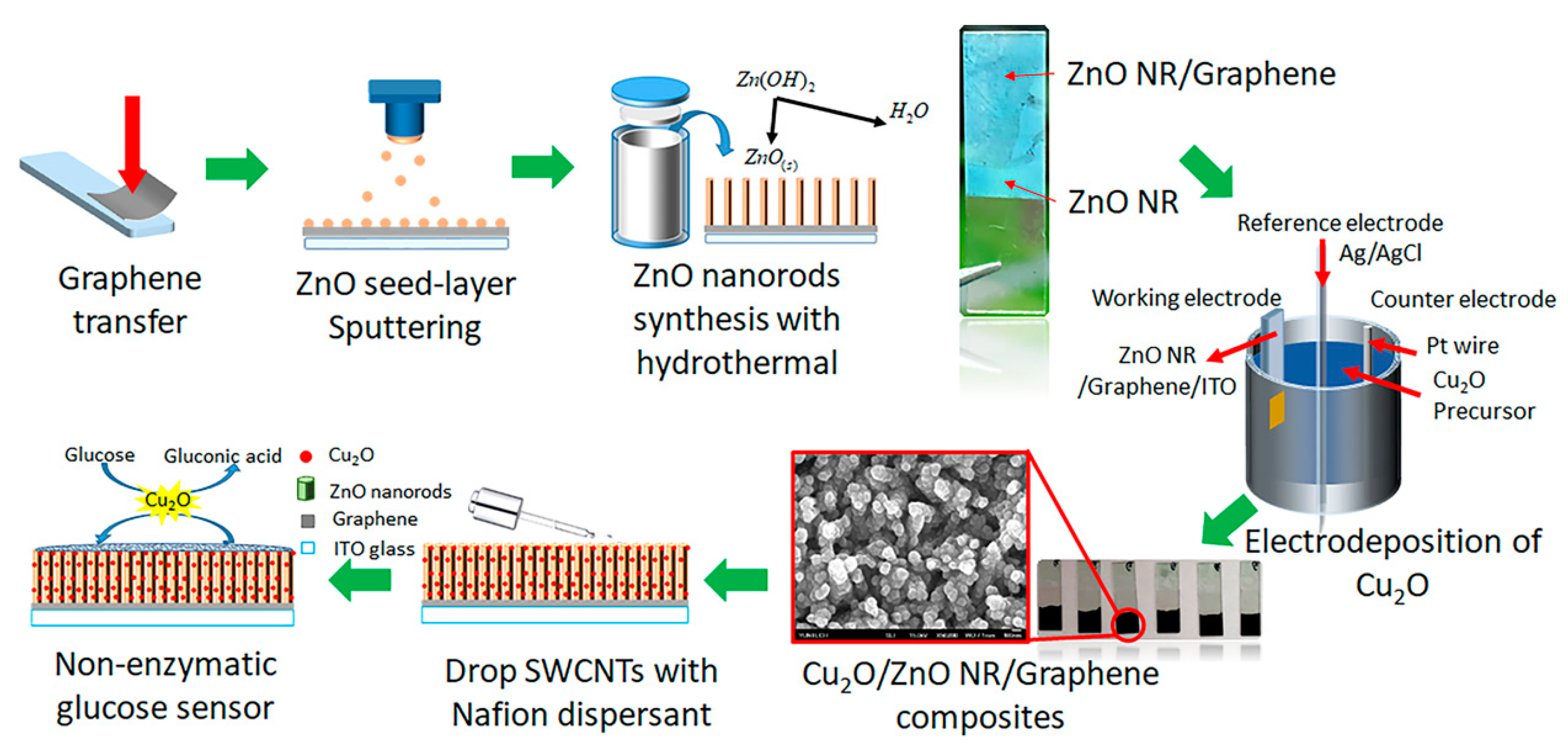
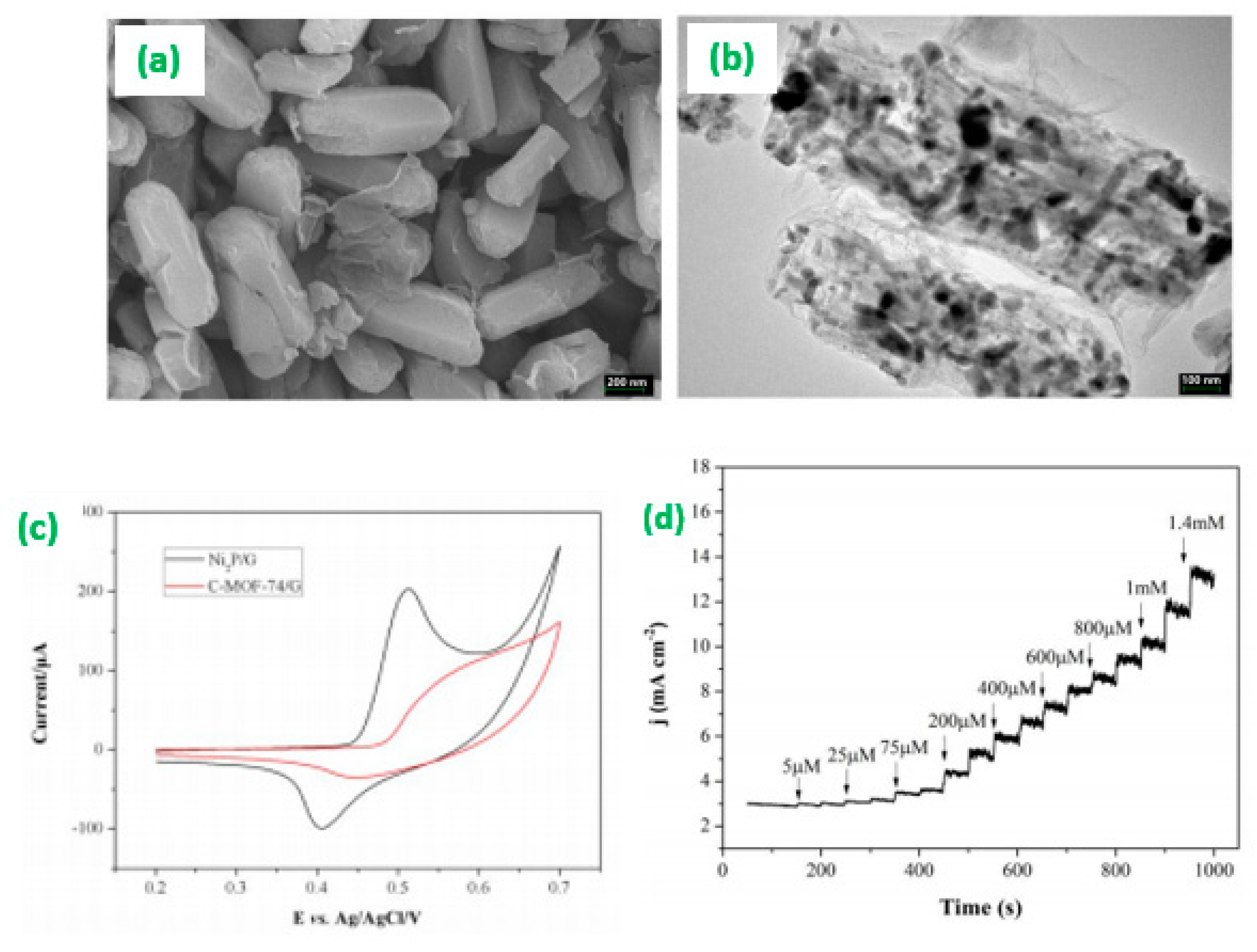

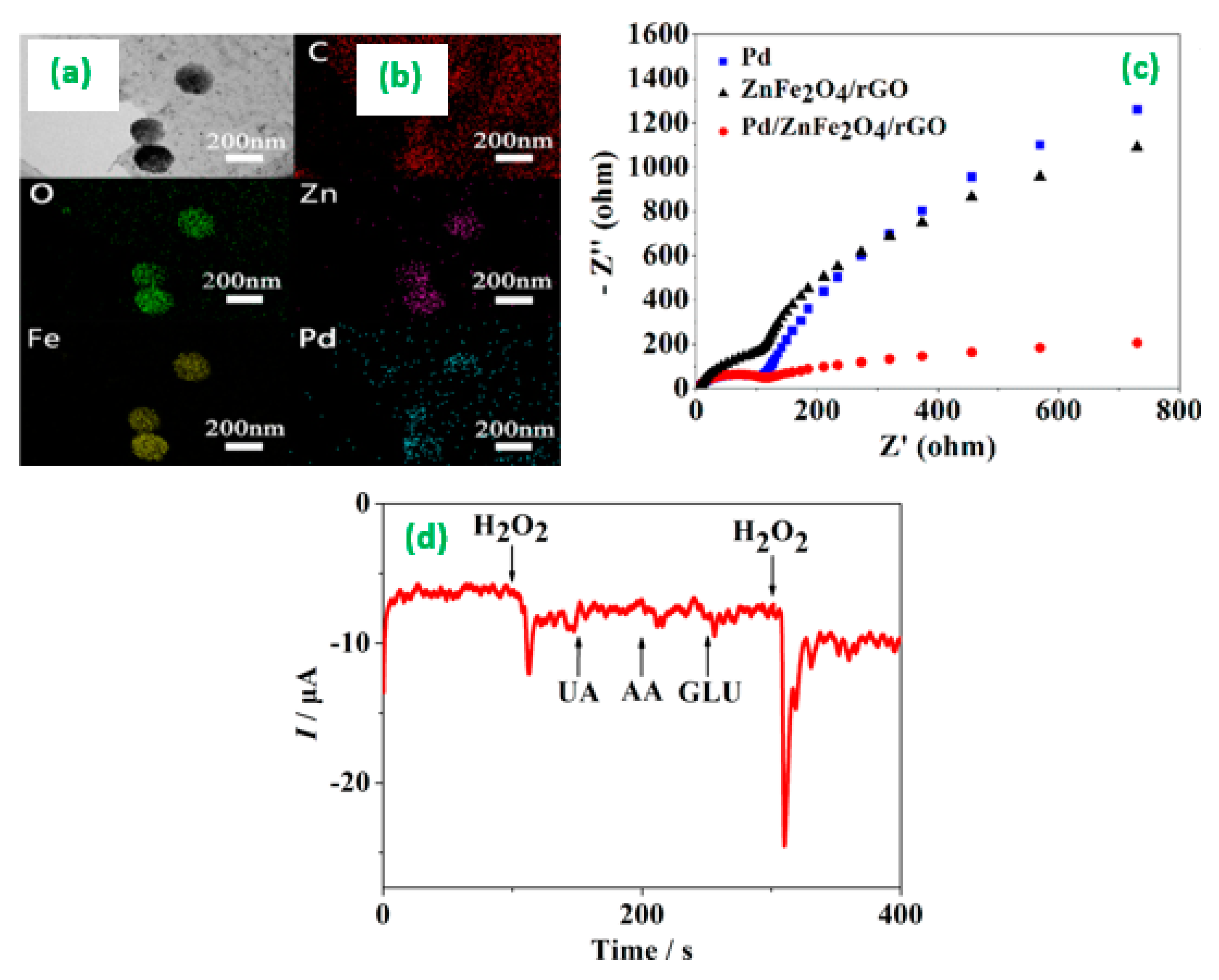
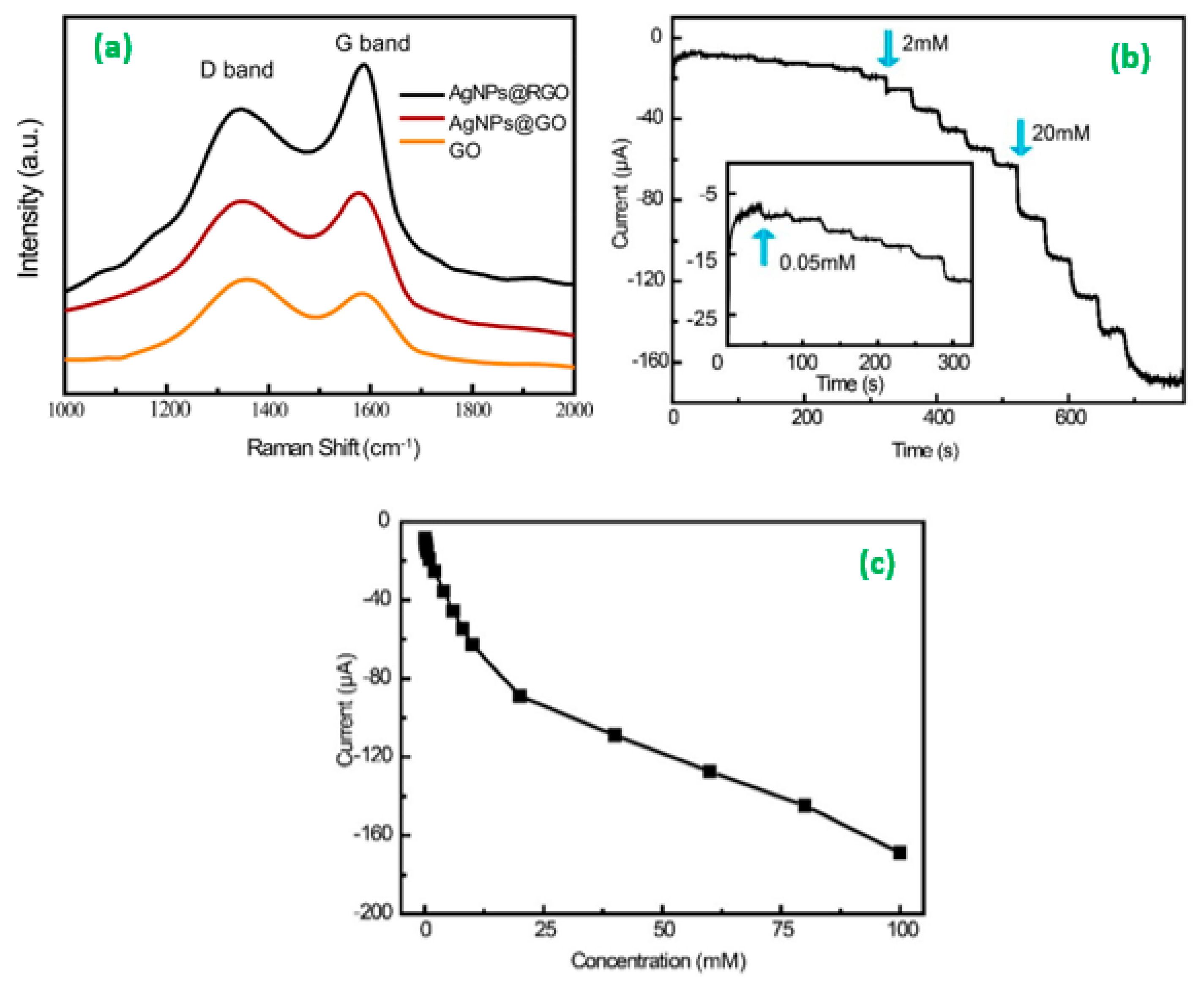
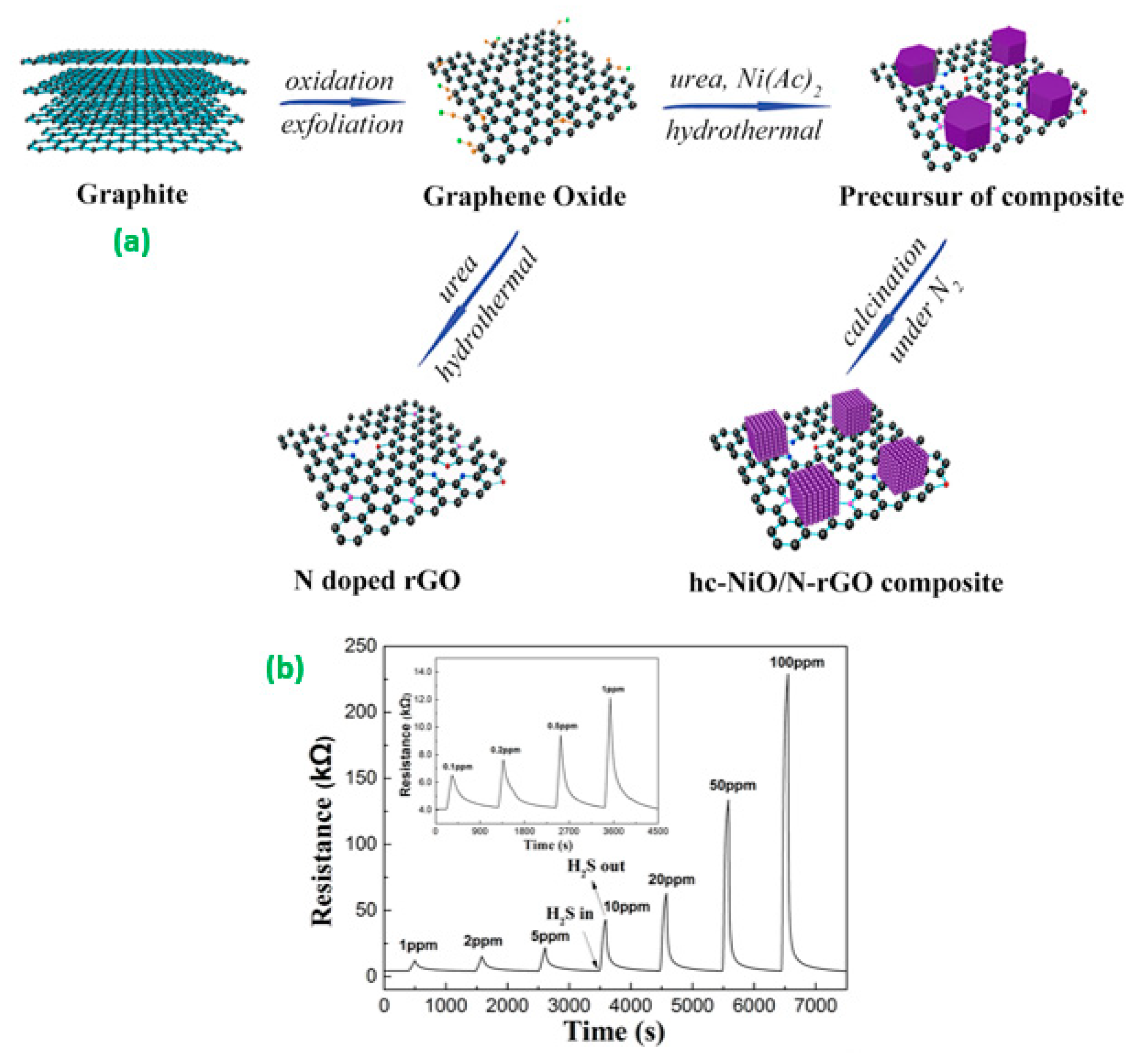


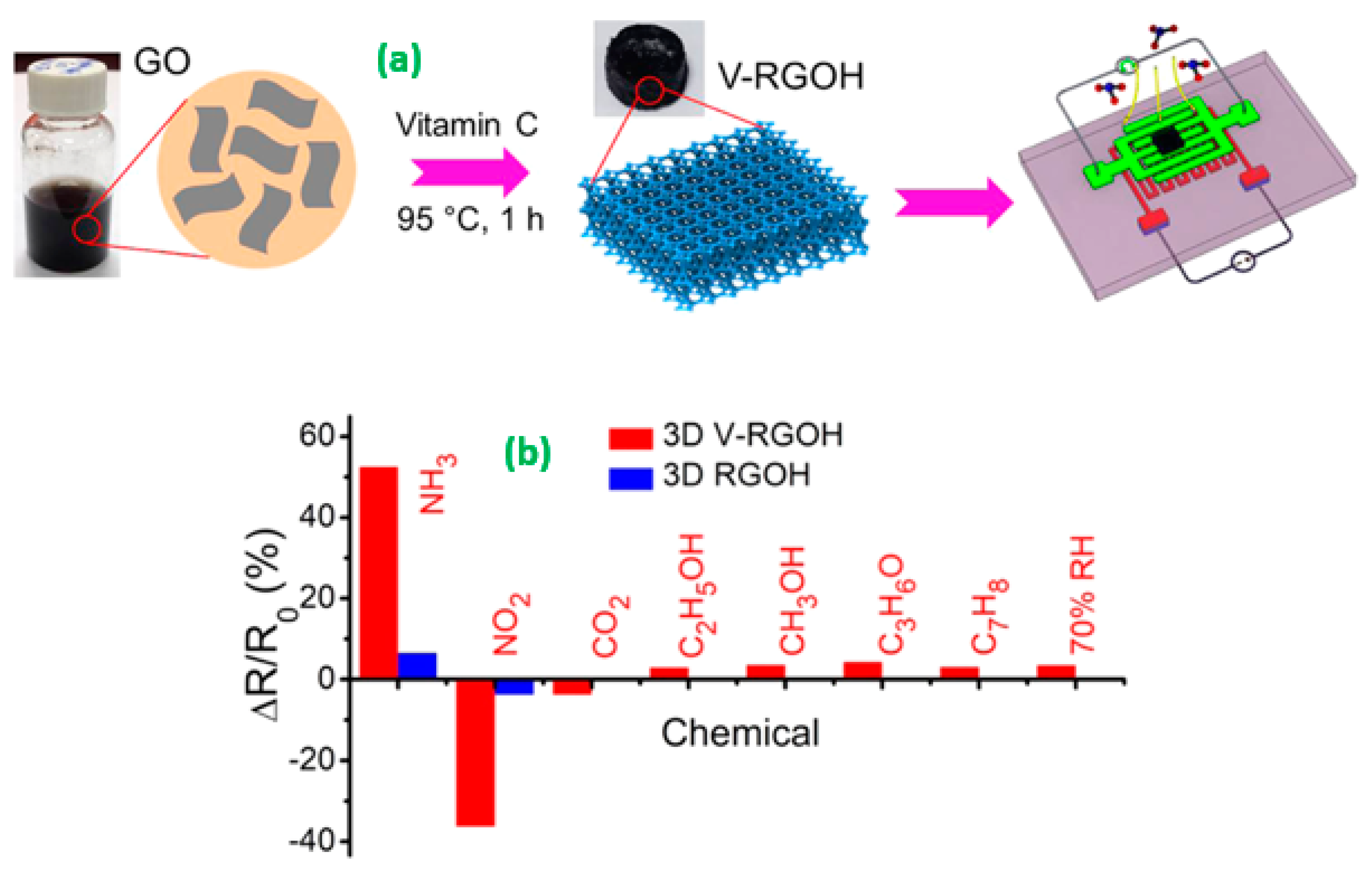
| Materials | Methods | Analytes | Detection Techniques | LOD (μM) | Sensitivity (μA mM−1 cm−2) | Linear Range (μM) | Ref. |
|---|---|---|---|---|---|---|---|
| Sr0.85Ce0.15FeO3 | Combustion | H2O2 | Amperometry | 10 | 60 | - | [3] |
| a P-L-Trp/GN | Electrochemical | Dopamine | c DPV | 0.06 | - | 0.2–100 | [4] |
| LaTiO3-Ag0.2 | Sol–gel | Glucose | Amperometry | 21 | 784.14 | 2.5–400 | [36] |
| LaNi0.6Co0.4O3 (LNC) | Sol–gel | Glucose | Amperometry | 800 | 643 | 0.05–200 | [37] |
| LaNi0.5Ti0.5O3 (LNT) | Chemical | Glucose | Amperometry | 0.07 | 1630.57 | 0.2–20 | [38] |
| GC/LaCoO3 | Microwave-assisted | Hydrazine | Amperometry | 15 | 561 | 100–15,000 | [49] |
| rGO/CuO | Chemical | Hydrazine | Amperometry | 9.8 | 3.87 | 1–400 | [51] |
| NaNbO3 | Solvothermal | Dopamine | DPV | 680 | 99 | 10–500 | [56] |
| RGO/ZIF-8 | In situ | Dopamine | DPV | 38 | - | 0.1–10 | [62] |
| RGO-PtNPs | Electrochemical | H2O2 | Amperometry | 0.2 | 459±3 | 0.5–3.475 | [64] |
| b Co3O4-HNS/G | Self-cross link | H2S | d GC | 0.1 | - | - | [90] |
| Pd/SnO2/RGO | One-pot route | NH3 | d GC | 5.0 | -- | 5–150 | [131] |
Publisher’s Note: MDPI stays neutral with regard to jurisdictional claims in published maps and institutional affiliations. |
© 2020 by the authors. Licensee MDPI, Basel, Switzerland. This article is an open access article distributed under the terms and conditions of the Creative Commons Attribution (CC BY) license (http://creativecommons.org/licenses/by/4.0/).
Share and Cite
Chen, T.-W.; Ramachandran, R.; Chen, S.-M.; Anushya, G.; Ramachandran, K. Graphene and Perovskite-Based Nanocomposite for Both Electrochemical and Gas Sensor Applications: An Overview. Sensors 2020, 20, 6755. https://doi.org/10.3390/s20236755
Chen T-W, Ramachandran R, Chen S-M, Anushya G, Ramachandran K. Graphene and Perovskite-Based Nanocomposite for Both Electrochemical and Gas Sensor Applications: An Overview. Sensors. 2020; 20(23):6755. https://doi.org/10.3390/s20236755
Chicago/Turabian StyleChen, Tse-Wei, Rasu Ramachandran, Shen-Ming Chen, Ganesan Anushya, and Kumarasamy Ramachandran. 2020. "Graphene and Perovskite-Based Nanocomposite for Both Electrochemical and Gas Sensor Applications: An Overview" Sensors 20, no. 23: 6755. https://doi.org/10.3390/s20236755
APA StyleChen, T.-W., Ramachandran, R., Chen, S.-M., Anushya, G., & Ramachandran, K. (2020). Graphene and Perovskite-Based Nanocomposite for Both Electrochemical and Gas Sensor Applications: An Overview. Sensors, 20(23), 6755. https://doi.org/10.3390/s20236755






